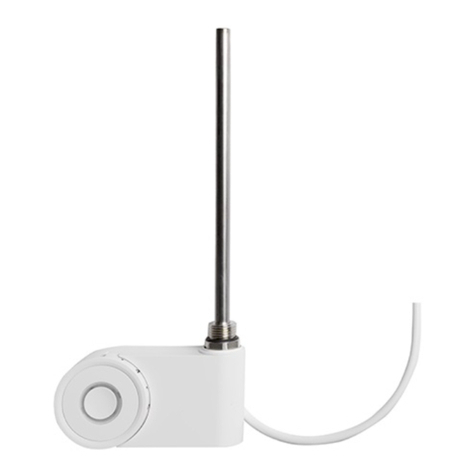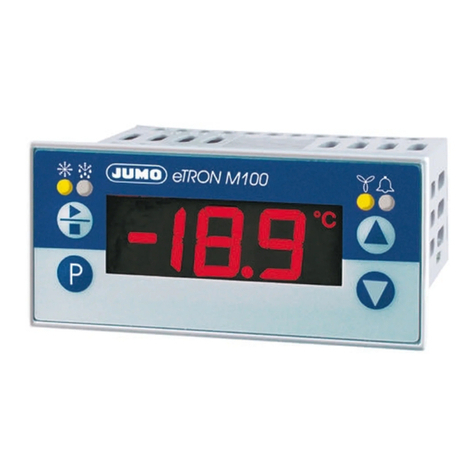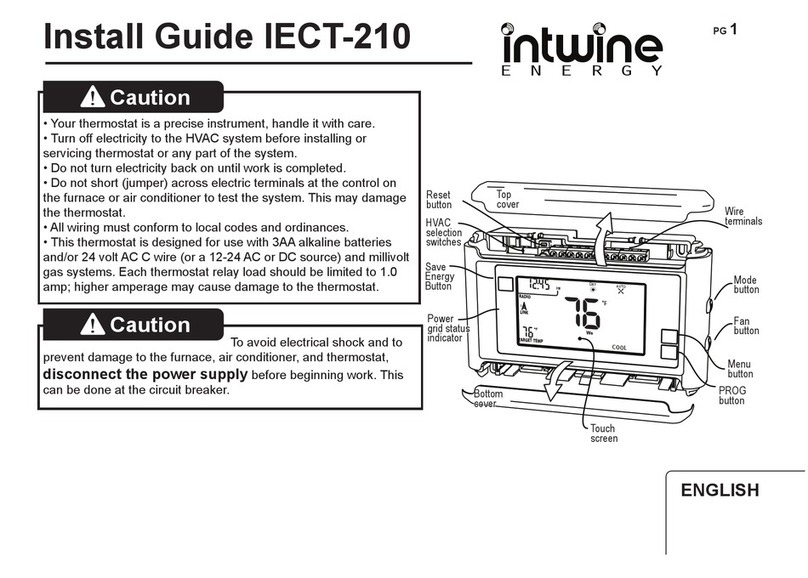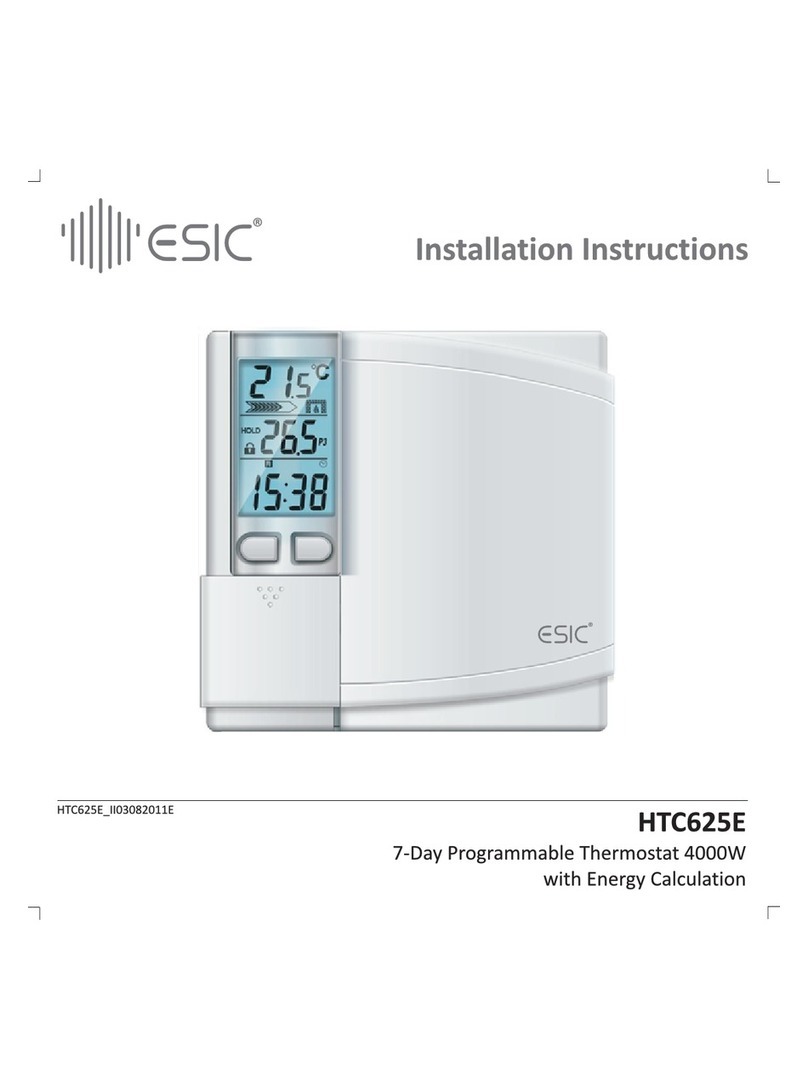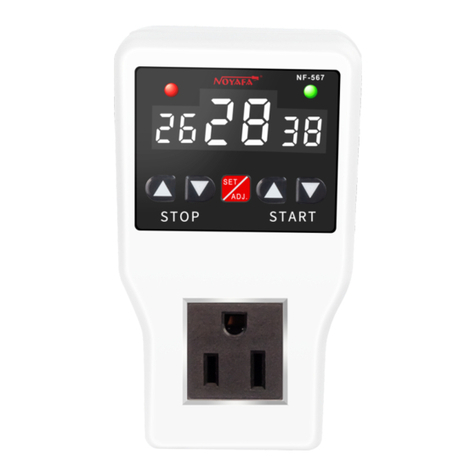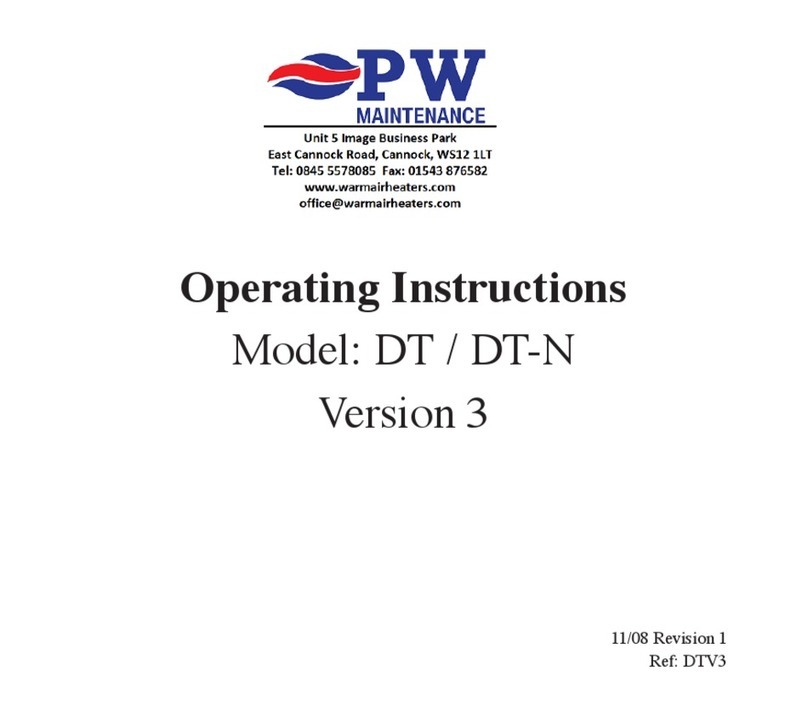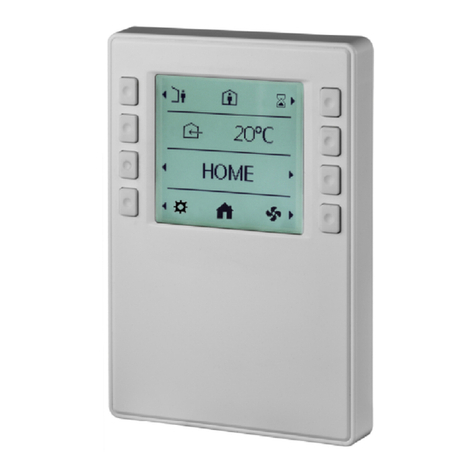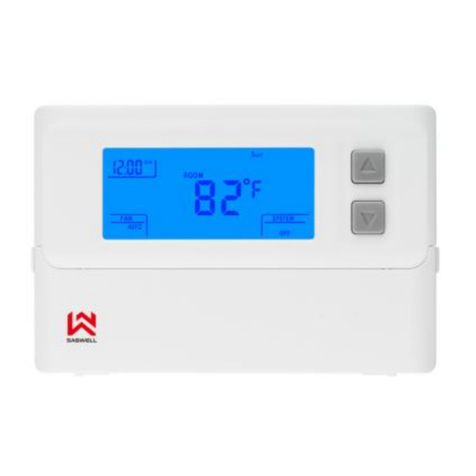AFG Arbonia WFS Quick setup guide

3
1
2
4
5
DE – Gebrauchs- und Montageanleitung Thermostat WFS für Elektro-Heizstab
EN – Instructions for use and installation instructions, WFS thermostat for electrical heating
element
IT – Istruzioni d'uso e di montaggio termostato WFS per barra termica elettrica
FR – Instructions d'utilisation et de montage Thermostat WFS d'ambiance pour l'élément chauf-
fant électrique
2013/08 • 6912022
AKP®
Arbonia AG
Amriswilerstrasse 50
CH-9320 Arbon
T +41 71 447 47 47
F +41 71 447 48 47
www.arbonia.ch
AKP®
AFG Arbonia-Forster-Riesa
GmbH
Heinrich-Schönberg-Str. 3
DE-01591 Riesa
T +49 3525 74 60
F +49 3525 74 62 57
www.arbonia.de
AKP®
Arbonia Kermi France Sárl
17A rue d’Altkirch
CS 70053
FR-68210 Hagenbach
T +33 389 40 02 53
C +33 389 40 04 25
www.arbonia.fr
AKP®
Ufcio Arbonia AG /
Kermi GmbH
Strada degli Angariari, 8
RSM-47891 Falciano
T +378 549 941 372
F +378 549 974 931
www.arbonia.it

2
DE – Gebrauchsanleitung
Zulässiger Gebrauch
Der Thermostat dient zur Regulierung der
Raumtemperatur oder der Temperatur des
Heizkörpers, z. B. zum Wärmen von Handtü-
chern, in Verbindung mit einem Elektro-Heiz-
stab in ortsfesten Heizkörpern.
Jeder andere Gebrauch ist nicht bestimmungs-
gemäß und daher unzulässig.
Sicherheitshinweise
►Das Gerät nicht vor der endgültigen und
ordnungsgemäßen Installation benutzen.
WARNUNG
Verbrennungsgefahr! Einige Teile
des Heizkörpers können sehr
heiß werden.
►Beaufsichtigen Sie Kinder, da-
mit diese nicht mit dem Gerät
spielen.
►Beachten Sie mitgeltende An-
leitungen des Heizstabs und
des Heizkörpers.
Das Gerät kann von Personen mit
beschränkten körperlichen, senso-
rischen und geistigen Fähigkeiten
oder mangelnder Erfahrung und
Wissen sowie Kindern ab 8 Jah-
ren und darüber benutzt werden,
wenn sie beaufsichtigt oder bezüg-
lich des sicheren Gebrauchs des Ge-
rätes unterwiesen wurden und die
daraus resultierenden Gefahren
verstehen.
Kinder jünger als 3Jahre sind vom
Gerät fernzuhalten, es sei denn, sie
werden ständig überwacht.
Kinder ab 3Jahren und jünger als
8 Jahre dürfen das Gerät unter
obigen Voraussetzungen nur ein-
und ausschalten, sofern das Gerät
in seiner normalen Gebrauchslage
platziert oder installiert ist.
Kinder ab 3Jahren und jünger als
8Jahre dürfen das Gerät nicht rei-
nigen und nicht die Wartung durch
den Benutzer durchführen.
Reinigung
►Trennen Sie das Gerät vor der Reinigung
oder Wartung von der Stromversorgung.
►Verwenden Sie nur milde, nicht scheuernde
Reinigungsmittel.
Reklamation
►Wenden Sie sich an Ihren Fachhandwerker.
Montage und Reparaturen
►Lassen Sie die Montage und Reparaturen
nur vom Fachhandwerker ausführen, damit
Ihre Gewährleistungsansprüche nicht erlö-
schen.
Entsorgung
►Führen Sie das Gerät der ge-
trennten Sammlung von Elektro-
und Elektronikgeräten zu. Beach-
ten Sie die örtlichen Vorschriften.

3
Anzeigen
Die LED-Anzeige Betriebsmodus (4) schaltet
sich automatisch ein, wenn der Temperatur-
regler bewegt wird. Um die Lebensdauer der
Batterien zu erhöhen, schaltet sich die Anzei-
ge nach längerer Nichtbenutzung ab. Boost-
Modus- und Batteriewechselanzeige bleiben
davon unberührt.
LED-Anzeige
Betriebsmodus (4)
Bedeutung
Blinkt langsam rot Heizphase
Blinkt langsam gelb Solltemperatur ist
erreicht, Heizstab
ist abgeschaltet
Blinkt schnell rot Boost-Modus ist
aktiv
Blinkt unregelmäßig gelb Batterie leer -
bitte wechseln
Batteriewechsel
Der Thermostat arbeitet mit 2 Batterien 1,5 V
vom Typ LR03 bzw. AAA.
Keine wiederauadbaren Batterien verwen-
den.
►Entfernen Sie den Gehäusedeckel (5) ge-
mäß Abb. F1.
►Wechseln Sie die Batterien. Dabei auf die
richtige Polung achten.
►Setzen Sie den Gehäusedeckel (5) wieder
auf.
Hinweis: Im Fall von leeren Batterien sendet
der Thermostat keine Funksignale mehr zum
Empfänger.
Wird über einen längeren Zeitraum kein Funk-
signal mehr empfangen, schaltet der Empfän-
ger den Heizstab aus Sicherheitsgründen ab.
Die Frostschutzfunktion bleibt jedoch über
einen Temperatursensor im Empfänger weiter-
hin aktiv.
DE – Montageanleitung
Das Gerät darf nur von einer Elektrofachkraft
(in Deutschland gemäß BGV A3) angeschlossen
werden.
Sicherheitshinweise
►Vor der Montage und Inbetriebnahme die-
se Anleitung gründlich lesen.
Bedien- und Anzeigeelemente
3
1
5
2
4
1 Temperaturregler
Raumtemperatur ca. 7–27 °C
Heizkörpertemperatur ca. 40–65 °C
2 Skala des Temperaturreglers
3 Boost-Taste
4 LED-Anzeige Betriebsmodus
5 Gehäusedeckel
Funktionen/Bedienung
Komfort-Modus – Temperaturregelung
Im Komfort-Modus hält der Thermostat das
Temperaturniveau durch Ein- und Ausschalten
des Heizstabs konstant.
►Stellen Sie am Temperaturregler (1) die
gewünschte Raumtemperatur bzw. das ge-
wünschte Temperaturniveau des Heizkör-
pers ein.
Die Position "
❄
" auf der Skala(2) kennzeich-
net die Frostschutz-Einstellung.
Boost-Modus
Im Boost-Modus heizt der Heizstab unab-
hängig vom eingestellten Temperaturniveau
durchgehend für 60Minuten. Danach schaltet
der Thermostat in den Komfort-Modus zurück.
►Um den Boost-Modus zu aktivieren oder
vorzeitig abzubrechen, drücken Sie kurz
die Taste(3).
Aus Sicherheitsgründen schaltet der Thermo-
stat bei Erreichen einer Raumtemperatur von
ca. 28 °C (Betriebsart Raumtemperaturrege-
lung) bzw. ca. 35°C (Betriebsart Handtuchwär-
men) ab.

4
Maximale
Schaltleistung
1800 W
Belastbarkeit des
Kontakts
8 A / 250 V ~ bei cos φ = 1
bzw.
2 A / 250 V ~ bei cos φ = 0,6
Leistungsaufnahme
im Stand-by-Modus
ca. 0,9 W
Isolationsart
Wandauslass
Schutzklasse I bzw.
Schutzklasse II
Schutzart
Wandauslass
IPX4 nach sachge-
mäßer Montage
Schutzbereiche in Räumen mit Bade-
bzw. Duscheinrichtung (Ausführungs-
beispiele siehe Abb. A)
• Gemäß nationalen Installationsnormen (in
Deutschland DIN VDE 0100-701) dürfen in
Räumen mit Badewanne oder Dusche elek-
trische Betriebsmittel nur in bestimmten
Bereichen montiert werden.
• Elektrische Geräte in oben genannten
Räumen sind zulässig, wenn diese durch
eine Fehlerstromschutzeinrichtung (RCD)
(in Deutschland gemäß DIN EN 61008-1
(VDE 0664-10)) geschützt sind.
• Steckdosen dürfen nur außerhalb der
Schutzbereiche montiert werden.
• Hinweis: Die Montage der Produkte im
Schutzbereich 1 ist vom Hersteller nicht zu-
gelassen.
►Folgende Produkte nur im Schutzbereich 2
oder außerhalb der Schutzbereiche montie-
ren:
–Heizkörper mit Heizstab (DIN 55900
"Beschichtungen für Raumheizkörper"
beachten)
–Thermostat WFS
–Wandauslass IPX4 mit Funkempfänger
Montage
Vorbereitende Tätigkeiten
►Sicherstellen, dass in Kabelreichweite des
Heizstabs eine Schalterdose (230 V, Absiche-
rung B16 A) vorhanden ist.
Für den Einbau des Funkempfängers empehlt
es sich, eine Schalterdose mit einer Einbautiefe
≥ 40mm und einem Durchmesser von 68mm
zu verwenden.
►Nach der Montage die Anleitung dem End-
verbraucher überlassen.
WARNUNG
Lebensgefahr durch Stromschlag!
►Gerät nur im spannungsfreien Zustand
montieren und anschließen.
Einsatzbedingungen
►Thermostat nur in Verbindung mit Elektro-
Heizstäben aus dem Lieferprogramm des
Herstellers montieren.
►Bei Montage in Räumen mit Bade- bzw.
Duscheinrichtungen: Schutzbereiche ge-
mäß nationalen Installationsnormen (in
Deutschland DIN VDE 0100-701) beachten.
Darüber hinaus alle örtlichen Vorschriften
beachten.
►Bei der Installation eine bauseitige Fehler-
stromschutzeinrichtung vorsehen (Auslöse-
grenze kleiner gleich 30 mA).
►Wird ein Gerät ohne Stecker direkt an die
fest verlegte elektrische Installation ange-
schlossen: Trennvorrichtung gemäß den
örtlichen Einrichtungsbestimmungen zur
Netztrennung einbauen.
►Gerät nur mit der zugelassenen Spannung
betreiben (siehe Typenschild).
►Gerät nur in der Schutzverpackung lagern
und transportieren.
Reklamation
►An den Lieferanten wenden.
Entsorgung
►Verpackung und nicht benötigte Teile dem
Recycling oder der ordnungsgemäßen
Entsorgung zuführen. Die örtlichen Vor-
schriften beachten.
Technische Merkmale (siehe Typen-
schild)
• Entspricht der Norm EN 60730-1, -2-9
• Batterien Thermostat: 2 x 1,5 V, Typ LR03
bzw. AAA
• Funkfrequenz: 868 MHz
Leistungsdaten Funkempfänger
Nennspannung 230 V AC
Leitungsquerschnitt 1 x 1,5 mm²
empfohlene
Aderendhülsen
L = 10 mm gemäß
DIN 46228

5
Die Schalterdose muss frei zugänglich sein und
darf nicht in der Projektionsäche des Heizkör-
pers liegen.
►Heizkörper und Heizstab montieren.
Thermostat und Funkempfänger/Wandaus-
lass montieren
►Lieferumfang auf Vollständigkeit und Schä-
den prüfen (siehe Abb. B).
►Thermostat gemäß Abb. C1 / C2 montieren.
►Funkempfänger und Wandauslass gemäß
Abb. D1-D5 montieren.
Elektrischer Anschluss
Das Gerät darf nur von einer Elektrofachkraft
angeschlossen werden.
►D5: Elektrischen Anschluss gemäß Schema
Abb. E1 (Schutzklasse I) bzw. E2 (Schutzklas-
se II) herstellen.
• Benennung der Adern:
–L' = Phase Heizstab (braun)
–L = Phase Netz (braun)
–N = Neutral Heizstab (blau)
–N = Neutral Netz (blau)
–PE = Schutzleiter (grün / gelb, nur bei
Schutzklasse I)
Funkkommunikation herstellen
►D6: Taste am Thermostat 2x drücken
–> LEDs (6) blinken weiß
►D7: Taste am Funkempfänger 1x drücken
–> LED (7) blinkt grün
Leuchtet die LED (7) dauerhaft für ca. 5Se-
kunden, ist der Einlernvorgang fehlgeschla-
gen. Einlernvorgang neu starten.
►D8: Taste am Thermostat 1 x drücken
–> LEDs (6 und 7) sind aus
Die Funkverbindung wurde erfolgreich her-
gestellt. Der Einlernzustand bleibt auch bei
Unterbrechung der Stromzufuhr gespei-
chert.
►D9: Spritzschutzabdeckung montieren
Die LED (8) zeigt den Betriebsmodus des Heiz-
stabs an.
Zustand Bedeutung
Leuchtet rot Heizphase
Leuchtet gelb Solltemperatur ist erreicht,
Heizstab ist abgeschaltet
Blinkt rot Funkkommunikation gestört,
Thermostat WFS überprüfen
Einstellung der Betriebsart
Der Thermostat ist im Auslieferungszustand
auf die Regulierung der Raumtemperatur
programmiert. Wird eine raumtemperaturun-
abhängige Regulierung der Temperatur des
Heizkörpers gewünscht (z. B. weil die Raum-
temperatur über eine Flächenheizung gere-
gelt wird), folgende Schritte gemäß Abb. F1-F3
ausführen:
►Gehäusedeckel (5) vorsichtig abnehmen.
►Drehschalter (9) auf Position „1“ stellen.
–LED-Anzeige (4) zeigt durch gelbes Blin-
ken die Umstellung an.
–Die Anzeige der Betriebsart erlischt.
–Betriebsart Handtuchwärmen ist aktiv.
►Gehäusedeckel (5) wieder aufsetzen.
Wird anstelle der Betriebsart Handtuchwär-
men wieder die Regulierung der Raumtempe-
ratur gewünscht, die oben genannten Schritte
wiederholen. Dazu den Drehschalter (9) auf
Position "0" stellen. Die LED-Anzeige (4) zeigt
durch rotes Blinken die Umstellung an.
Position des Drehschalters (9)
• "0" = Betriebsart Raumtemperaturregelung
• "1" = Betriebsart Handtuchwärmen
Anzeige der eingestellten Betriebsart
►Boost-Taste (3) ca. 10 Sekunden lang ge-
drückt halten.
–LED-Anzeige(4) blinkt rot
–> Betriebsart Raumtemperaturregelung
–LED-Anzeige(4) blinkt gelb
–> Betriebsart Handtuchwärmen
–Die Anzeige der Betriebsart erlischt.
–Der Thermostat ist betriebsbereit.
EN – Instructions for use
Permissible use
The thermostat is used for regulating the room
temperature or the temperature of the radia-
tor, for e.g. for warming towels, in conjunction
with an electrical heating element in stationa-
ry radiators.
Any other use is contrary to its intended pur-
pose and therefore not permissible.
Safety instructions
►Do not use the device before complete and
proper installation.

6
WARNING
Risk of burns! Some parts of the
radiator may be very hot.
►Supervise children so that they
do not play with the device.
►Observe the applicable instruc-
tion manuals of the heating el-
ement and the radiator.
The device may be used by persons
with limited physical, sensory and
mental abilities or by persons with
little experience and knowledge
as well as children above 8 years
under supervision or they are in-
structed regarding the safe use of
the device and understand the risk
resulting therefrom.
Children less than 3 years are to be
kept away from the device unless
they are monitored continuously.
Children above 3 years and less than
8 years may only switch on and off
the device under above mentioned
conditions, provided the device is
placed and installed in its normal
position.
Children above 3 years and less
than 8 years may not clean the
device and may also not carry out
maintenance by the user.
Cleaning
►Disconnect the device from the power sup-
ply before cleaning or maintenance.
►Use only mild, non-abrasive cleansing
agents.
Complaint
►Contact your local dealer.
Installation and repairs
►Have the installation and repairs performed
by a specialized tradesman so that your
claims under warranty are not forfeited.
Disposal
►Dispose of the unit in the sepa-
rate collection for electrical and
electronic devices. Observe local
regulations.
Control and indicator elements
3
1
5
2
4
1 Temperature controller
room temperature approximately 7–27°C
radiator temperature approximately
40–65°C
2 Scale of the temperature controller
3 Boost button
4 LED display mode
5 Housing cover
Functions/operation
Comfort mode - temperature regulation
In the comfort mode, the thermostat retains
the temperature level by switching the heating
element on and off constantly.
►Set the desired room temperature or the
temperature level of the radiator on the
temperature controller (1).
The "
❄
" position on the scale (2) indicates the
antifreeze setup.

7
Boost mode
In the boost mode, regardless of the set tem-
perature level, the heating element heats con-
tinuously for 60 minutes. The thermostat then
switches back to the comfort mode.
►To activate the boost mode or early cancel-
lation, press the button (3) briey.
For safety reasons, the thermostat switches off
on reaching a room temperature of approxi-
mately 28 °C (room temperature regulation
mode) or approximately 35°C (towel warming
mode).
Display
The LED display mode (4) switches on auto-
matically when the temperature controller is
moved. To increase the life of the batteries,
the display switches off if it is not used for a
prolonged period. Boost mode and battery
change display remain unaffected.
LED display
mode (4)
Meaning
Blinks red slowly Heating phase
Blinks yellow slowly Setpoint tem-
perature has been
reached, heat-
ing element is
switched off
Blinks red quickly Boost mode is
active
Blinks yellow irregularly Battery empty -
kindly change
Battery change
The thermostat operates with 2 batteries 1.5 V
of the type LR03 or AAA.
Do not use rechargeable batteries.
►Remove the housing cover (5) according to
Fig. F1.
►Change the batteries. Pay attention to the
correct polarity.
►Fit the housing cover (5) again.
Note: in case of empty batteries, the thermo-
stat no longer sends radio signals to the recei-
ver.
If no radio signal is received for a longer peri-
od, the receiver switches off the heating ele-
ment due to safety reasons. However, the an-
tifreeze function remains active in the receiver
via a temperature sensor.
EN – Installation instructions
The device may only be connected by an elec-
trical specialist. An electrical specialist is so-
meone whose technical training, knowledge,
experience and knowledge of the relevant
regulations allows him to assess the tasks assi-
gned to him and recognise potential hazards.
Safety instructions
►Read these instructions thoroughly prior to
installation and commissioning.
►After installation pass the instructions on
to the end used.
WARNING
Danger of death from electric shocks!
►Install and connect the device only in the
de-energized state.
Operating conditions
►Install thermostat only in conjunction
with electrical heating elements from the
manufacturer's product range.
►When installing in rooms with bath or sho-
wer facilities: take into account protective
areas according to national installation
standards (in Germany DIN VDE 0100-701).
Also follow all local regulations.
►When installing , provide an on-site residu-
al-current-operated protective device (with
trigger limit less than or equal to 30 mA).
►If a device without a connector is directly
connected to the xed electrical installa-
tions: install an isolator in accordance with
the local provisions for mains disconnec-
tion.
►Operate the device only with the approved
voltage (see type plate).
►Store and transport the device only in the
protective packaging.
Complaint
►Contact the supplier.
Disposal
►Packaging and any parts that are not nee-
ded should be recycled or disposed of pro-
perly. Observe local regulations.

8
Technical features (see type plate)
• Corresponds to the standard EN 60730-1,
-2-9
• Batteries thermostat: 2 x 1.5 V, type LR03
or AAA
• Radio frequency: 868 MHz
Performance data radio receiver
Nominal voltage 230 V AC
Cable cross section 1 x 1.5 mm²
recommended wire
end ferrules
L = 10 mm according to
DIN 46228
Maximum
switching capacity
1800 W
Resilience of the
contact
8 A / 250 V ~ at cos φ = 1
or
2 A / 250 V ~ at cos φ = 0,6
Power consumption
in the stand-by
mode
approximately 0.9 W
Insulation type wall
outlet
Protection class I or
protection class II
Protection type
wall outlet
IPX4 after proper
installation
Protective areas in rooms with bath
or shower facilities (for installation
examples, see Fig.A)
• According to national installation stan-
dards (in Germany DIN VDE 0100-701)
electrical equipment may only be installed
in specic areas in rooms with bathtubs or
shower facilities.
• Electrical equipment is permitted in the
rooms referred to above if it is protected by
a residual current protective device (RCD)
(in Germany according to DIN EN 61008-1
(VDE 0664-10)).
• Sockets may only be installed outside safety
areas.
• Note: the manufacturer does not approve
the installation of products in protective
area 1.
►Install the following products only in pro-
tective area2 or outside the protective are-
as:
–Radiator with heating element (DIN
55900 note "coatings for radiators".)
–Thermostat WFS
–Wall outlet IPX4 with radio receiver
Installation
Preparatory activities
►Ensure that a outlet socket (230 V, fuse B16
A) is there within the reach of the cable of
the heating element.
To install a radio receiver, it is advisable to
use a outlet socket with an installation depth
≥ 40mm and diameter of 68mm.
The outlet socket must be freely accessible and
may not be in the projection surface of the ra-
diator.
►Install radiator and heating element.
Install thermostat and radio receiver/wall
outlet
►Check the delivery for completeness and
damages (see Fig. B).
►Install thermostat according to Fig. C1 / C2 .
►Install radio receiver and wall outlet accor-
ding to Fig. D1–D5.
Electrical connection
The device may only be connected by an elec-
trical specialist.
►D5: setup electrical connection according to
the diagram Fig. E1 (protection class I) or E2
(protection class II).
• Designation of the wires:
–L' = phase heating element (brown)
–L = phase network (brown)
–N = neutral heating element (blue)
–N = neutral network (blue)
–PE = protective conductor (green / yel-
low, only for protection class I)
Setup radio communication
►D6: press the button on the thermostat 2x
–> LEDs (6) blink white
►D7: press the button on the radio receiver 1x
–> LED (7) blinks green
If the LED (7) lights continuously for appro-
ximately 5seconds, the learning procedure
has failed. Restart the learning procedure.
►D8: press the button on the thermostat 1 x
–> LEDs (6 and 7) are off
Radio communication was setup successful-
ly. The learning procedure remains saved
even after interrupting the power supply.
►D9: install splash protection cover
The LED (8) displays the operating mode of the
heating element.

9
State Meaning
Lights red Heating phase
Lights yellow Setpoint temperature has
been reached, heating ele-
ment is switched off
Blinks red Radio communication
impaired, check thermostat
WFS
Setup of the operating mode
In the as-delivered condition, the thermostat
is programmed for regulating the room tem-
perature. If a regulation independent of the
room temperature of the radiator tempera-
ture is desired (e.g. because the room tempe-
rature is regulated via panel heating), execute
the following steps according to Fig. F1-F3:
►Remove the housing cover (5) carefully.
►Set the rotary switch (9) to the "1" position.
–LED display (4) displays the conversion
by blinking yellow.
–Display of the operating mode goes out.
–Towel warming mode is active.
►Re-attach the housing cover (5).
If regulation of room temperature is desired
instead of towel warming, repeat the above
mentioned steps. For this, set the rotary switch
(9) to the "0" position. The LED display(4) dis-
plays the conversion by blinking red.
Position of the rotary switch (9)
• "0" = Room temperature regulation mode
• "1" = Towel warming mode
Display of the set mode
►Keep the boost button(3) pressed for ap-
proximately 10seconds.
–LED display(4) blinks red
–> room temperature regulation mode
–LED display(4) blinks yellow
–> towel warming mode
–Display of the operating mode goes out.
–The thermostat is ready to operate.
IT – Istruzioni per l'uso
Uso consentito
Il termostato serve per la regolazione della
temperatura ambiente o della temperatura
del radiatore, ad esempio per il riscaldamento
degli asciugamani, in unione ad una barra ter-
mina elettrica in radiatori ssi.
Ogni altro uso non è considerato conforme alle
disposizioni ed è quindi non ammesso.
Indicazioni di sicurezza
►Non utilizzare l'apparecchio prima
dell'installazione denitiva e conforme alle
norme.
ATTENZIONE
Pericolo di ustioni! Alcune parti
del radiatore possono diventare
molto calde.
►Sorvegliare i bambini afnché
non giochino con l'apparec-
chio.
►Osservare le istruzioni vigenti
della barra termica e del radia-
tore.
Questo apparecchio può essere
utilizzato da persone con limitate
capacità siche, sensoriali o men-
tali o con scarsa esperienza o co-
noscenza e da bambini dagli 8 anni
in su, se non lasciati soli o se istruiti
sull’utilizzo sicuro dell’apparecchio
e in grado di capire i pericoli che
possono sorgere.
I bambini di età inferiore ai 3 anni
devono essere mantenuti lontani
dall'apparecchio, a meno che non
vengano costantemente controllati.
I bambini dai 3 agli 8 anni pos-
sono solo accendere e spegnere
l'apparecchio nel rispetto delle
condizioni sopra indicate e con

10
l'apparecchio posizionato o instal-
lato nelle sua posizione d'uso nor-
male.
I bambini dai 3 agli 8 anni non pos-
sono pulire l'apparecchio e non
possono eseguire la manutenzione
ad opera dell'utente.
Pulizia
►Staccare l'apparecchio dall'alimentazione
di corrente prima della pulizia o della ma-
nutenzione.
►Utilizzare solo detergenti delicati e non ab-
rasivi.
Reclamo
►Contattare l'installatore specializzato.
Montaggio e riparazioni
►Per non perdere la garanzia sul prodotto,
far eseguire il montaggio e le riparazioni
solo da un installatore specializzato.
Smaltimento
►Portare l'apparecchio presso i
punti di raccolta separata per ap-
parecchi elettrici ed elettronici.
Osservare le disposizioni locali.
Elementi di comando e di visualizza-
zione
3
1
5
2
4
1 Regolatore di temperatura
temperatura ambiente circa 7–27 °C
temperatura del radiatore circa 40–65 °C
2 Scala del regolatore di temperatura
3 Tasto Boost
4 Visualizzazione LED modalità di esercizio
5 Coperchio dell'alloggiamento
Funzioni/Comando
Modalità comfort – regolazione della tempe-
ratura
Nella modalità comfort il termostato mantiene
costante il livello della temperatura attraverso
l'accensione e lo spegnimento della barra ter-
mica.
►Sul regolatore di temperatura (1), im-
postare la temperatura ambiente desidera-
ta o il livello di temperatura desiderato del
radiatore.
La posizione "
❄
" sulla scala (2) indica
l'impostazione protezione antigelo.
Modalità boost
In modalità boost, la barra termica riscalda,
indipendentemente dal livello di temperatura
impostato, in modo continuo per 60 minuti.
Successivamente il termostato torna nella mo-
dalità comfort.
►Per attivare la modalità boost o per inter-
romperla anticipatamente, premere breve-
mente il tasto (3).

11
Per motivi di sicurezza il termostato si spegne
al raggiungimento di una temperatura ambi-
ente di circa 28 °C (tipo di esercizio regolazio-
ne della temperatura ambiente) o circa 35 °C
(tipo di esercizio riscaldamento asciugamano).
Visualizzazioni
La visualizzazione LED modalità di esercizio
(4) si attiva automaticamente se il regolatore
di temperatura si muove. Per aumentare la
durata delle batterie, il display si spegne dopo
un lungo periodo di non utilizzo. La modalità
boost e l'indicatore del cambio batterie resta-
no invariati.
Visualizzazione LED
modalità di esercizio(4)
Signicato
Lampeggia lentamente
in rosso
Fase di riscalda-
mento
Lampeggia lentamente
in giallo
La temperatu-
ra nominale è
stata raggiunta,
la barra termica è
spenta
Lampeggia velocemente
in rosso
La modalità boost
è attiva
Lampeggia in modo
irregolare in giallo
Batteria scarica -
sostituirla
Sostituzione delle batterie
Il termostato funziona con 2 batterie 1,5 V del
tipo LR03 o AAA.
Non utilizzare batterie ricaricabili.
►Rimuovere il coperchio dell'alloggiamento
(5) secondo la g. F1.
►Sostituire le batterie. Fare attenzione alla
corretta polarità.
►Riapplicare il coperchio dell'alloggiamento
(5).
Nota: nel caso di batterie scariche il termostato
non invia più segnali radio al ricevitore.
Se per un lungo periodo non viene più ricevu-
to alcun segnale radio, il ricevitore spegne, per
motivi di sicurezza, la barra termica. Tuttavia,
la funzione antigelo resta attiva grazie ad un
sensore di temperatura nel ricevitore.
IT – Istruzioni di montaggio
L'apparecchio può essere installato solo da un
elettricista specializzato. Elettricista qualica-
to è colui che per formazione, conoscenza ed
esperienza tecnica nonché conoscenza delle
direttive speciche in materia, è in grado di
valutare i lavori che gli vengono afdati e di
riconoscere i possibili pericoli che ne derivano.
Indicazioni di sicurezza
►Leggere attentamente le istruzioni prima
di procedere al montaggio e alla messa in
esercizio.
►Dopo il montaggio cedere le istruzioni
all'utente finale.
ATTENZIONE
Pericolo di morte per scossa elettrica!
►Montare e collegare l'apparecchio solo in
assenza di tensione.
Condizioni di utilizzo
►Montare il termostato solo a barre termiche
elettriche dal volume di fornitura del pro-
duttore.
►Con il montaggio in locali adibiti a bagno
o doccia: osservare le zone di protezione
secondo le norma di installazione nazionali
(in Germania DIN VDE 0100-701). Inoltre os-
servare tutte le disposizioni locali.
►Al momento dell‘installazione il cliente
deve prevedere un dispositivo di protezio-
ne dalle correnti di guasto (con un limite di
intervento minore o uguale a 30 mA).
►Se l'apparecchio viene collegato senza spi-
na direttamente all'installazione elettrica a
posa ssa: installare il dispositivo di sezio-
namento secondo le disposizioni locali rela-
tive al dispositivo per la separazione di rete.
►Far funzionare l'apparecchio solo con la
tensione consentita (vedere targhetta).
►Depositare e trasportare l'apparecchio solo
nell'imballo protettivo.
Reclamo
►Rivolgersi ai fornitori.
Smaltimento
►Procedere al riciclaggio o al corretto smalti-
mento dell'imballo e delle parti non neces-
sarie. Osservare le disposizioni locali.

12
Caratteristiche tecniche (vedere tar-
ghetta)
• Conforme alla norma EN 60730-1, -2-9
• Batterie termostato: 2 x 1,5 V, tipo LR03 o
AAA
• Radiofrequenza: 868 MHz
Prestazioni radioricevitore
Tensione nominale 230 V AC
Sezione del cavo 1 x 1,5 mm²
Manicotti dei
conduttori
consigliati
L = 10 mm secondo
DIN 46228
Capacità di
controllo massima
1800 W
Caricabilità del
contatto
8 A / 250 V ~ con cos φ = 1
o
2 A / 250 V ~ con cos φ = 0,6
Assorbimento
di potenza in
modalità stand-by
ca. 0,9 W
Tipo di isolamento
presa dell'aria a
muro
Classe di protezione I o
classe di protezione II
Tipo di protezione
presa dell'aria a
muro
IPX4 secondo un mon-
taggio corretto
Zone di protezione in locali con vasca
o doccia (esempi di applicazione
vedere g. A)
• In base alle norme di installazione naziona-
li (in Germania DINVDE 0100-701) in locali
con vasca o doccia, i mezzi di esercizio elet-
trici possono essere montati solo in zone
speciche.
• Gli apparecchi elettrici nei locali sopra citati
sono ammessi, solo se sono protetti tramite
un dispositivo di protezione contro cor-
rente di guasto (RCD) (in Germania secondo
DIN EN 61008-1 (VDE 0664-10)).
• Le prese possono essere montate solo al di
fuori delle zone di protezione.
• Nota: il montaggio del prodotto nella zona
di protezione 1 non è consentito dal pro-
duttore.
►Montare i seguenti prodotti solo nella zona
di protezione 2 o al di fuori delle zone di
protezione:
–radiatore con barra termica (DIN 55900
"Rivestimenti per radiatori per ambienti")
–Termostato WFS
–Presa dell'aria a muro IPX4 con radiori-
cevitore
Montaggio
Operazioni di preparazione
►Assicurarsi che alla portata del cavo della
barra termica sia presente una presa per in-
terruttore (230V, fusibile B16A).
Per il montaggio del radioricevitore si consig-
lia di utilizzare una presa per interruttore con
profondità di montaggio ≥ 40mm ed un dia-
metro di 68mm.
La presa per interruttore deve essere facil-
mente accessibile e non deve trovarsi nelle su-
perci di proiezione del radiatore.
►Montare il radiatore e la barra termica.
Montaggio del termostato e del radioricevi-
tore/ presa dell'aria a muro
►Controllare che la fornitura sia completa e
che non presenti danni (vedere g. B).
►Montare il termostato secondo la g.
C1 / C2 .
►Montare il radioricevitore e la presa
dell'aria a muro secondo la g. D1–D5.
Collegamento elettrico
L'apparecchio può essere installato solo da un
elettricista specializzato.
►D5: realizzare il collegamento elettrico se-
condo lo schema g. E1 (classe di protezio-
ne I) o E2 (classe di protezione II).
• Denominazione dei conduttori:
–L' = fase barra termica (marrone)
–L = fase rete (marrone)
–N = neutro barra termica (blu)
–N = neutro rete (blu)
–PE = conduttore di protezione (ver-
de / giallo, solo con classe di protezione I)
Realizzazione della comunicazione radio
►D6: premere 2volte il tasto sul termostato
–> i LED (6) lampeggiano in bianco
►D7: premere 1volta il tasto sul radioricevitore
–> il LED (7) lampeggia in verde
Se il LED (7) per circa 5secondi, la procedu-
ra di apprendimento è fallita. Riavviare la
procedura di apprendimento.

13
►D8: premere 1volta il tasto sul termostato
–> i LED (6 e 7) sono spenti
Il collegamento radio è stato realizzato
con successo. Lo stato di apprendimento
resta memorizzato anche con interruzione
dell'alimentazione di corrente.
►D9: montare la copertura di protezione
contro gli spruzzi
Il LED (8) indica la modalità di esercizio della
barra termica.
Stato Signicato
Illuminato in
rosso
Fase di riscaldamento
Illuminato in
giallo
La temperatura nominale
è stata raggiunta, la barra
termica è spenta
Lampeggia in
rosso
Comunicazione radio distur-
bata, controllare il termosta-
to WFS
Impostazione del tipo di esercizio
Alla consegna il termostato è programma-
to sulla regolazione della temperatura am-
biente. Se si desidera una regolazione della
temperatura del radiatore dipendente dalla
temperatura ambiente (ad esempio perché la
temperatura ambiente viene regolata da una
riscaldamento superciale), eseguire i seguenti
passi secondo la g. F1-F3:
►Rimuovere con cautela il coperchio
dell'alloggiamento (5).
►Posizionare la manopola (9) sulla posizione
„1“.
–La visualizzazione LED (4) mostra, attra-
verso il lampeggiare giallo, la commuta-
zione.
–La visualizzazione del tipo di esercizio
scompare.
–Il tipo di esercizio riscaldamento asciu-
gamano è attivo.
►Riapplicare il coperchio dell'alloggiamento
(5).
Se al posto del tipo di esercizio riscaldamento
asciugamano si desidera nuovamente la rego-
lazione della temperatura ambiente, ripetere i
passi sopra indicati. Allo scopo posizionare la
manopola (9) sulla posizione "0". La visualizza-
zione LED (4) mostra, attraverso il lampeggiare
rosso, la commutazione.
Posizione della manopola (9)
• "0" = tipo di esercizio regolazione della
temperatura ambiente
• "1" = tipo di esercizio riscaldamento asci-
ugamano
Visualizzazione del tipo di esercizio impostato
►Tenere premuto il tasto boost (3) per circa
10 secondi.
–La visualizzazione LED (4) lampeggia
in rosso
–> tipo di esercizio regolazione della
temperatura ambiente
–La visualizzazione LED (4) lampeggia
in giallo
–> tipo di esercizio riscaldamento asci-
ugamano
–La visualizzazione del tipo di esercizio
scompare.
–Il termostato è pronto all'esercizio.
FR – Instructions d'utilisation
Utilisation conforme
Le thermostat sert à la régulation de la tempé-
rature ambiante ou de la température du ra-
diateur, par ex. pour chauffer des serviettes, en
association avec l'élément chauffant électrique
dans les radiateurs xes.
Toute autre utilisation n'est pas conforme à
l'usage prévu et est donc interdite.
Consignes de sécurité
►Ne pas utiliser l'appareil avant l'installation
conforme et dénitive.
AVERTISSEMENT
Risque de brûlure! Certains élé-
ments du radiateur peuvent être
brûlants.
►Surveiller les enfants an d'évi-
ter qu'ils ne jouent avec l'appa-
reil.
►Respecter également les ins-
tructions relatives à l'élément
chauffant et au radiateur.

14
L'appareil peut être utilisé par des
personnes présentant un handi-
cap physique, sensoriel et mental
ou manquant de connaissances et
d'expérience ainsi que par des en-
fants à partir de 8 ans s'ils sont sous
surveillance ou ont été instruits sur
une utilisation sécurisée de l'appa-
reil et s'ils comprennent les dangers
encourus.
Les enfants de moins de 3 ans doi-
vent être tenus à l'écart de l'appa-
reil, à moins d'être sous surveillance
permanente.
Les enfants de plus de 3 ans et de
moins de 8 ans ne peuvent allu-
mer et éteindre l'appareil que si les
conditions antérieures sont respec-
tées et dans la mesure où l'appareil
est installé ou situé dans sa position
habituelle de fonctionnement.
Les enfants de plus de 3 ans et de
moins de 8 ans ne sont autorisés ni
à nettoyer l'appareil ni à effectuer
la maintenance relevant de l'utilisa-
teur.
Nettoyage
►Avant le nettoyage ou la maintenance, dé-
brancher l'appareil de l'alimentation élec-
trique.
►N'utiliser que des détergents doux, non
agressifs.
Réclamation
►Le cas échéant, s'adresser à un installateur
spécialisé.
Montage et réparations
►Seul un installateur spécialisé est habilité à
effectuer le montage et les réparations an
de préserver les droits de garantie.
Traitement des déchets
►Apporter l'appareil au collecteur
d'appareils électriques et électro-
niques. Respecter les prescriptions
locales.
Éléments de commande et d'af-
chage
3
1
5
2
4
1 Régulateur de température température
ambiante env. 7–27 °C
température radiateur env. 40–65 °C
2 Graduation du régulateur de température
3 Touche Boost
4 Témoin LED Mode de fonctionnement
5 Couvercle de boîtier
Fonctions/Commande
Mode Confort – Régulation de température
En mode Confort, le thermostat maintient la
température à un niveau constant par allu-
mage et extinction de l'élément chauffant.
►La température ambiante souhaitée ou le
niveau de température du radiateur sou-
haité se règle sur le régulateur de tempé-
rature (1).
La position «
❄
» de la graduation (2) désigne
le réglage hors gel.
Mode Boost
Indépendamment du niveau de température
réglé, en mode Boost, l'élément chauffant
fonctionne de manière continue pendant
60minutes. Ensuite, le thermostat revient en
mode Confort.

15
►Pour activer ou interrompre prématuré-
ment le mode Boost, appuyer brièvement
sur la touche(3).
Pour des raisons de sécurité, le thermostat se
désactive à l'atteinte d'une température am-
biante de 28 °C (mode de fonctionnement
Régulation de température ambiante) ou de
35°C (mode de fonctionnement Chauffage de
serviettes).
Témoins
Le témoin LED Mode de fonctionnement(4) se
désactive automatiquement lorsque le régula-
teur de température est déplacé. An d'aug-
menter la durée de vie des piles, le témoin se
désactive en cas de non-utilisation prolongée.
Cela ne s'applique pas au témoin du mode
Boost et de changement de piles.
Témoin LED
Mode de fonctionne-
ment(4)
Signication
Clignotement lent en
rouge
Phase de chauf-
fage
Clignotement lent en
jaune
Température de
consigne atteinte,
élément chauffant
désactivé
Clignotement rapide en
rouge
Mode Boost activé
Clignotement irrégulier
en jaune
Pile épuisée -
remplacer
Changement de pile
Le thermostat fonctionne avec 2 piles 1,5V de
type LR03 ou AAA.
Ne pas utiliser de piles rechargeables.
►Ôter le couvercle du boîtier(5) selon g. F1.
►Remplacer les piles. Veiller à respecter la
polarité.
►Replacer le couvercle de boîtier(5).
Remarque : si les piles sont épuisées, le ther-
mostat n'envoie plus de signal radio au récep-
teur.
Si aucun signal radio n'est reçu pendant une
période prolongée, le récepteur désactive l'élé-
ment chauffant pour des raisons de sécurité.
La fonction Hors gel est toutefois maintenue
active via une sonde thermique du récepteur.
FR – Instructions de montage
Le raccordement de l'appareil ne doit être
exécuté que par un électricien spécialisé. Un
électricien spécialisé est une personne qui du
fait de sa formation, de ses connaissances, de
ses expériences ainsi que de sa connaissance
des prescriptions applicables sait évaluer les
travaux qui lui sont conés et reconnaître les
éventuels dangers.
Consignes de sécurité
►Avant le montage et la mise en service, lire
attentivement ces instructions.
►Après le montage, remettre les instructions
à l'utilisateur final.
AVERTISSEMENT
Danger de mort par électrocution!
►Monter et raccorder l'appareil unique-
ment lorsqu'il est hors tension.
Conditions d'utilisation
►Monter le thermostat uniquement en as-
sociation avec les éléments chauffants
électriques du programme de livraison du
fabricant.
►En cas de montage dans des pièces équi-
pées de baignoires ou de douches: respec-
ter les zones de protection conformément
aux normes d'installations nationales (en
Allemagne DIN VDE 0100-701). Respecter
également l'ensemble des dispositions lo-
cales en vigueur.
►Lors de l'installation: prévoir un système de
protection contre les courants de court-cir-
cuit (limite de déclenchement inférieure à
30mA).
►Si un appareil est raccordé sans connecteur
directement à l'installation électrique xe:
monter un disjoncteur conformément aux
prescriptions locales d'équipement pour
l'isolation du réseau.
►N'exploiter l'appareil qu'à la tension admis-
sible (voir la plaque signalétique).
►Toujours entreposer et transporter l'appa-
reil dans son emballage de protection.
Réclamation
►S'adresser au fournisseur.

16
Traitement des déchets
►Apporter l'emballage et les pièces non uti-
lisées dans un centre de recyclage ou un
centre d'élimination des déchets réglemen-
taire. Respecter les prescriptions locales.
Caractéristiques techniques (voir la
plaque signalétique)
• Correspond à la norme EN 60730-1, -2-9
• Piles thermostat: 2x1,5V de type LR03 ou
AAA
• Fréquence radio: 868MHz
Données de puissance récepteur à commande
radio
Tension nominale 230V CA
Section de câble 1x1,5mm²
Embouts de
conducteurs
recommandés
L = 10mm selon
DIN 46228
Puissance de
coupure maximale
1800W
Charge admissible
du contact
8A / 250V ~ à cos φ = 1
ou
2A / 250V ~ à cos φ = 0,6
Puissance absorbée
en mode Veille
env. 0,9W
Type d'isolation
prise murale
Classe de protectionI
ou classe de protec-
tionII
Indice de
protection
Prise murale
IPX4 après un montage
correct
Zones de protection dans les pièces
avec installation de bain ou de
douche (exemples d'application, voir
g.A)
• Conformément aux normes nationales
d'installation (en Allemagne DIN VDE 0100-
701), les appareils électriques ne peuvent
être installés que dans des zones dénies
dans les pièces équipées d'une baignoire
ou d'une douche.
• Les appareils électriques sont admis dans
les pièces mentionnées ci-dessus lorsqu'ils
sont protégés avec un système de protec-
tion contre les courants de court-circuit
(RCD) (en Allemagne selon DIN EN 61008-1
(VDE 0664-10)).
• Les prises de courant ne peuvent être mon-
tées qu'en dehors des zones de protection.
• Remarque : le montage des produits dans la
zone de protection 1 n'est pas autorisé par
le fabricant.
►Ne monter les produits suivants que dans
la zone de protection 2 ou en dehors des
zones de protection:
–Radiateur avec élément chauffant
(DIN 55900 « Revêtements pour radia-
teurs de chauffage»)
–Thermostat WFS
–Prise murale IPX4 avec récepteur à com-
mande radio
Montage
Tâches préparatoires
►S'assurer qu'un boîtier d'interrupteur est
disponible à portée du câble de l'élément
chauffant (230V, fusible B16 A).
Pour le montage d'un récepteur à commande
radio, il est recommandé d'utiliser un boîtier
d'interrupteur d'une profondeur d'encastre-
ment ≥40mm et d'un diamètre de 68mm.
Les boîtiers d'interrupteur doivent être libre-
ment accessibles et ne doivent pas se trouver
dans la surface de projection du radiateur.
►Monter le radiateur et l'élément chauffant.
Monter le thermostat et le récepteur à com-
mande radio/prise murale
►Contrôler l'exhaustivité et l'absence de
dommage de la livraison (voir g.B).
►Monter le thermostat selon la g. C1/C2 .
►Monter le récepteur à commande radio et
la prise murale selon g. D1.D5.
Raccordement électrique
Seul un électricien spécialisé est habilité à rac-
corder l'appareil.
►D5: effectuer le raccordement selon sché-
ma de la g. E1 (classe de protection I) ou
E2 (classe de protection II).
• Désignation des conducteurs:
–L' = phase élément chauffant (marron)
–L = phase réseau (marron)
–N = neutre élément chauffant (bleu)
–N = neutre réseau (bleu)
–PE = conducteur de protection (vert/
jaune, uniquement si classe de protec-
tionI)

17
Établir la communication radio
►D6: appuyer 2 fois sur la touche du thermostat
–> les LED(6) clignotent en blanc
►D7: appuyer 1 fois sur la touche du récep-
teur radio
–> La LED(7) clignote en vert
Si la LED(7) reste allumée en continu
pendant env. 5 secondes, le processus de
programmation a échoué. Recommencer le
processus de programmation.
►D8: appuyer 1 fois sur la touche du thermostat
–> les LED(6 et 7) sont éteintes
La liaison radio a été établie avec succès.
L'état de programmation reste enregistré,
y compris en cas de coupure de l'alimenta-
tion.
►D9: monter une protection anti-projections
La LED(8) indique le mode de fonctionnement
de l'élément de chauffage.
État Signication
Allumé en
rouge
Phase de chauffage
Allumé en
jaune
Température de consigne
atteinte, élément chauffant
désactivé
Clignotement
en rouge
Communication radio per-
turbée, vérier le thermostat
WFS
Réglage du mode de fonctionnement
À l'état de livraison, le thermostat est pro-
grammé pour la régulation de la température
ambiante. Si une régulation en fonction de la
température ambiante est souhaitée pour le
radiateur (par ex. parce que la température
ambiante est régulée via un chauffage de sur-
face), procéder selon g. F1-F3:
►Ôter le couvercle de boîtier(5) avec précau-
tion.
►Placer le commutateur rotatif(9) sur la po-
sition«1».
–Le témoin LED (4) indique le change-
ment en clignotant en jaune.
–Le témoin du mode de fonctionnement
s'éteint.
–Le mode de fonctionnement Chauffage
de serviettes est activé.
►Replacer le couvercle de boîtier(5).
Si la régulation de la température ambiante
est préférée au mode de fonctionnement
Chauffage de serviettes, répéter la procédure
antérieure. Ensuite, placer le commutateur ro-
tatif(9) sur la position«0». Le témoin LED(4)
indique le changement en clignotant en jaune.
Position du commutateur rotatif(9)
• « 0» = mode de fonctionnement Régula-
tion de température ambiante
• «1» = mode de fonctionnement Chauffage
de serviettes
Afchage du mode de fonctionnement para-
métré
►Maintenir la touche Boost (3) enfoncée
pendant 10secondes.
–Le témoin LED (4) clignote en rouge
–> mode de fonctionnement Régulation
de température ambiante
–Le témoin LED(4) clignote en jaune –>
mode de fonctionnement Chauffage de
serviettes
–Le témoin du mode de fonctionnement
s'éteint.
–Le thermostat est prêt à fonctionner.

18
C1
1
0
2
2
1
0
A
+
–
+
–
B
C2

19
D4
2x
6
1x
8
7
1x
D5
D6
D9
D7
D8
ca. 90 mm
9 mm
D2
D3
≥40 mm
D1

20
N
N
L'
L
N
N
PE
L'
L
E2
E1
5
01
2
3
4
5
9
3
4
1
2
5
F2
F3
F1
Table of contents
Languages:
Other AFG Thermostat manuals
Popular Thermostat manuals by other brands
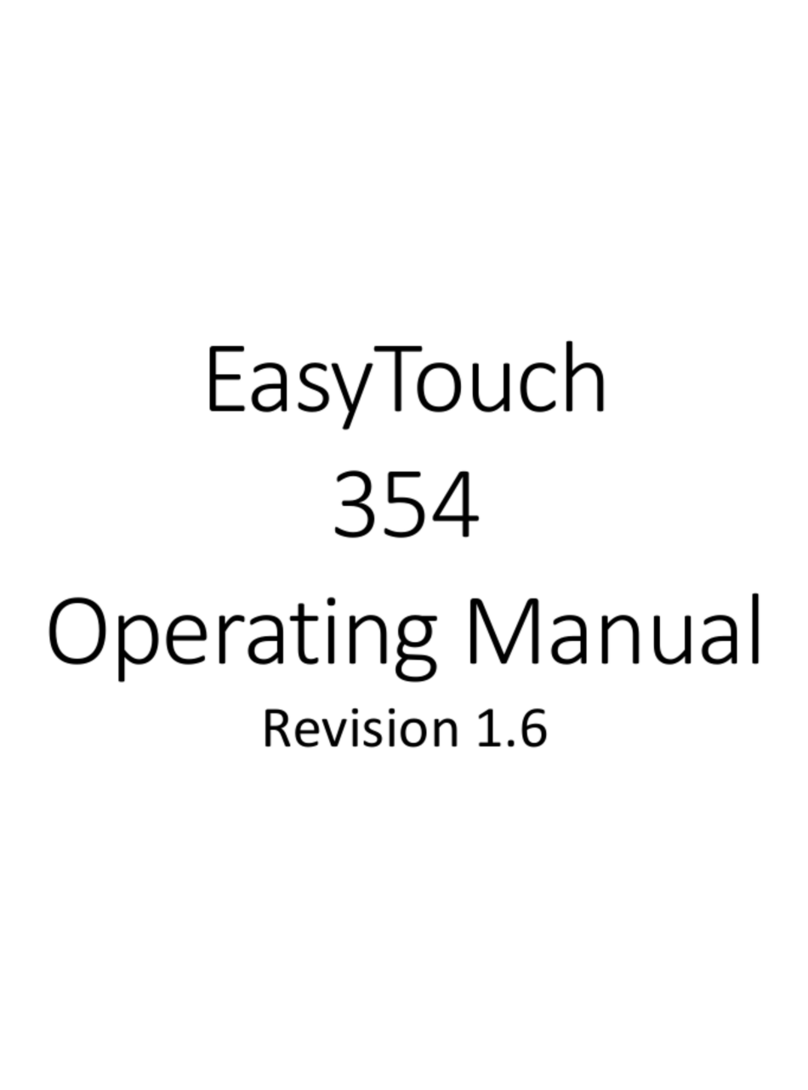
Easy Touch
Easy Touch 354 operating manual
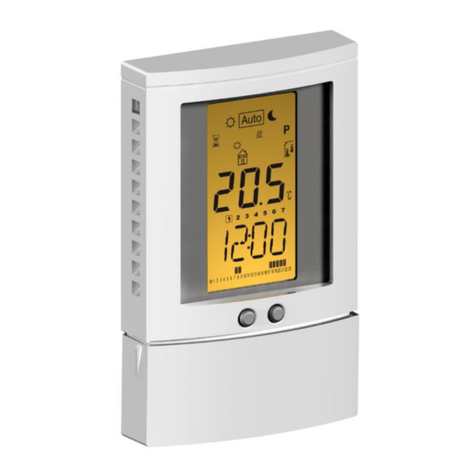
Fenix
Fenix Watts 860 user guide
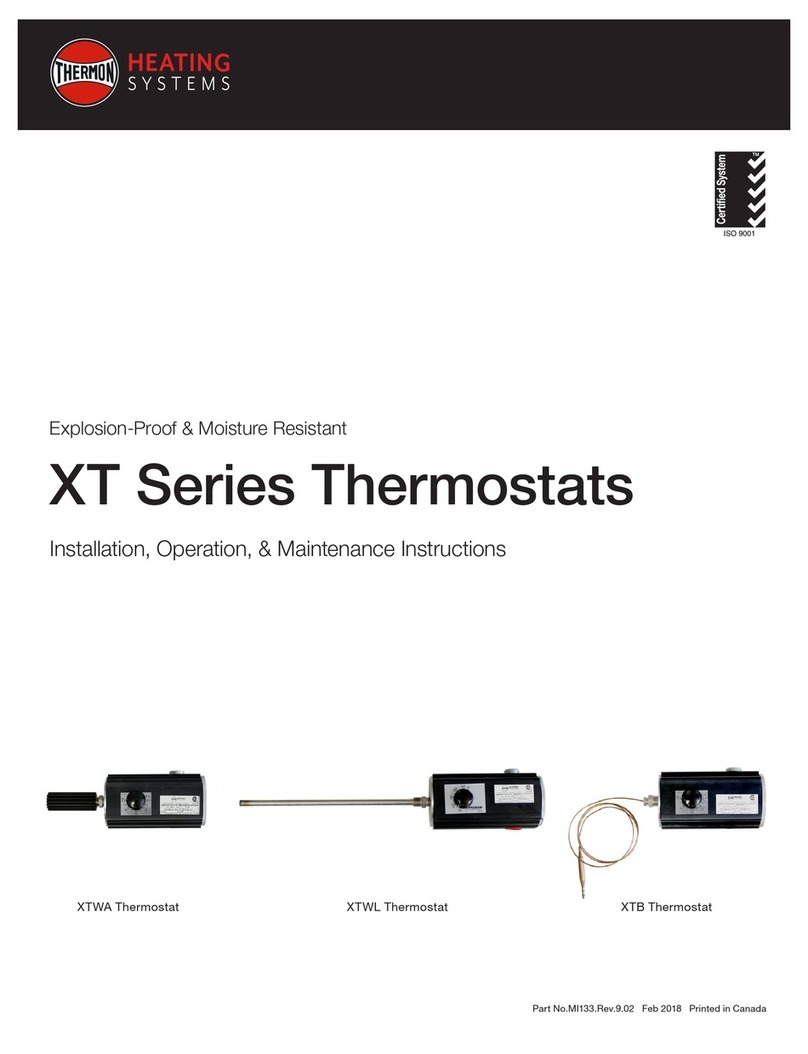
Thermon
Thermon XT Series Installation, operation & maintenance instructions

OJ Electronics
OJ Electronics MWD5-1999-UAC3 instructions

Thermosense
Thermosense STP322 instruction manual
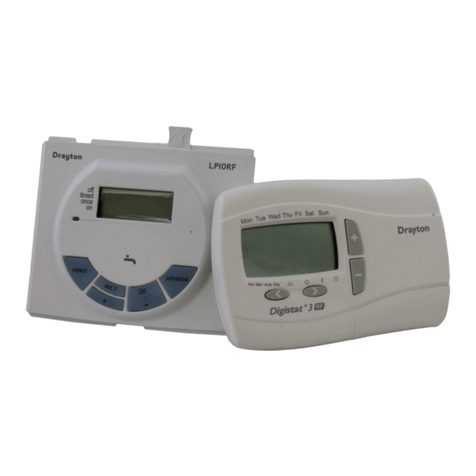
Worcester
Worcester DT10RF Operating and installation
